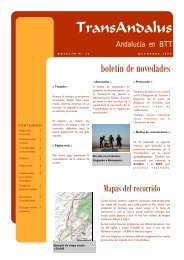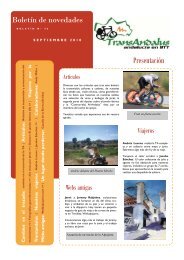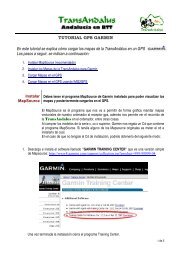CADIZ Roadbook - TransAndalus
CADIZ Roadbook - TransAndalus
CADIZ Roadbook - TransAndalus
You also want an ePaper? Increase the reach of your titles
YUMPU automatically turns print PDFs into web optimized ePapers that Google loves.
TRANSANDALUS ROAD BOOK<br />
PROVINCE OF CÁDIZ<br />
Sanlúcar de Barrameda – El Colmenar<br />
Section 1<br />
Sanlúcar de Barrameda – El Puerto de Santa<br />
María<br />
40 kms<br />
Section 2 El Puerto de Santa María – Puerto Real 11.50 kms<br />
Section 3 Puerto Real – Chiclana 23.30 kms<br />
Section 4 Chiclana - Conil 26.80 kms<br />
Section 5 Conil - Barbate 26.30 kms<br />
Section 6 Barbate – Zahara de los Atunes 9.55 kms<br />
Section 7 Zahara de los Atunes – Tarifa 34 kms<br />
Section 8 Tarifa – Puerto de El Bujeo 29.85 kms<br />
Section 9 Puerto de El Bujeo – Algeciras 26.30 kms<br />
Section 10 Algeciras – Castellar Viejo 43.60 kms.<br />
Section 11 Castellar Viejo – Jimena de la Frontera 21.20 Kms.<br />
Section 12 Jimena de la Frontera – El Colmenar 40.10 Kms.<br />
Total distance travelled through the province of Cádiz 332.50 kms<br />
� DESCRIPTION<br />
Crossing the Guadalquivir, the river that provides Andalucía’s<br />
backbone, you enter its southernmost province. Cádiz represents a<br />
meeting point of continents and seas; Europe and Africa are hardly<br />
14 kms apart, while the waters of the Atlantic and Mediterranean<br />
mix the in the Estrecho de Gibralter (Straits of Gibraltar). This<br />
position has shaped its environment and history, and in particular<br />
its climate: the province’s mountains receive the highest levels of<br />
rainfall of the whole country despite being in the heart of dry Spain;<br />
and the frequency of its most well-known winds, the ‘Levante’ and<br />
‘Poniente’ (eastwind and westwind). The complex geology of Cádiz,<br />
which comprises three main entities (quaternary sediments,<br />
sandstones and limestones) has favoured a topography varying from<br />
rolling hills to steep mountain ranges, with a vegetation alternating<br />
between almost desert-like spots to leafy ‘Laurisilvas’ (laurel forests),<br />
unique in the continental Europe - the pine and cork oak forests<br />
that make up the wooded areas are particularly remarkable. Its<br />
coastline alternates between extensive beaches and marshes and<br />
cliffs, and with the exception of few spots, it has been spared the<br />
effects of property speculation.<br />
The history and pre-history of this province has left an important<br />
legacy: numerous cave paintings; well-preserved Roman cities,<br />
necropolises, roads, aqueducts, and countless murals and<br />
monuments - not forgetting the architecture of its villages,<br />
[sometimes masked by the changes of the last 50 years].<br />
The economy of the province has been traditionally dominated by<br />
the primary sector: fishing on the coasts, and farming and cattleraising<br />
in the fields, together with forestry and cork production. In<br />
the second half of the twentieth century the bahías gaditanas<br />
(Algeciras and Cádiz) developed as major industrial centres which<br />
made a major contribution to the growth of the population in these<br />
area, and along with the area around Jerez de la Frontera they<br />
make up the three major centres of industrial activity in the<br />
province. In the last quarter of the twentieth century tourist<br />
development has begun to significantly change the landscape and<br />
the local society and economy leading, as we enter the 21st century,<br />
to a rampant speculation and settlement although some places have<br />
managed to hold onto their undoubted charm.<br />
Our passage through the tierras gaditanas will take in all of these<br />
aspects: starting with the gentle hills of the western countryside and<br />
the Bay of Cádiz, going on to see the coastlines of Chiclana, Conil<br />
and Barbate, and then, almost reaching Tarifa, riding into the<br />
mountains of the Sierras del Estrecho and Los Alcornocales (the<br />
cork tree forests), and then, before leaving the province of Cádiz, we<br />
skirt skirting the mountain range of the Serranía de Grazalema,<br />
(which we leave behind us at Montejaque).<br />
It’s best for the touring cyclist to be forewarned: while at the start of<br />
this route Cádiz welcome us with gentleness and courtesy, it will see<br />
us off demanding the utmost effort of our legs - although without<br />
doubt, having rewarded our senses and inspired us to return to<br />
enjoy its many charms.






